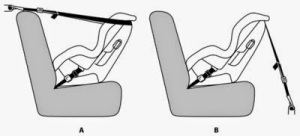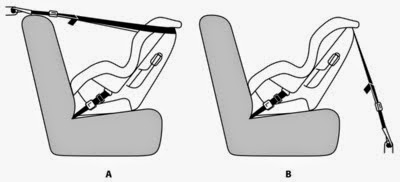The other day, I wrote about How To and Why Tether When Forward Facing Car Seats? However, there’s a bit more to learn about tethering, including the fact that certain convertible car seats can be tethered while rear-facing! Today, I’ll talk about how to do so and why you’d potentially want to consider it.
You Can Tether Rear-Facing?
Yes! While the majority of convertible car seats cannot currently be tethered rear-facing in the United States, four manufacturers are more forward-thinking and have made this possible. As of July 2014, those manufacturers are Britax, Diono, Combi, and Peg Perego. These are the only manufacturers of seats that can potentially be tethered rear-facing, and only a few of their seats can actually be tethered in this fashion. If your seat isn’t on this list, don’t do this, and simply focus on tethering when forward-facing when the time is right.
Which Current Car Seats Allow Tethering while Rear-Facing?
Britax – Advocate, Boulevard, Highway, Marathon, Pavilion, and Roundabout.
Combi – Coccoro.
Diono – Radian R100, Radian R120, Radian RXT, Rainier, Pacifica, and Olympia.
Peg Perego – Primo Viaggio Convertible.

What Options Exist for Rear-Facing Tethering?
There are two approaches to tethering while rear-facing: Swedish style and Australian style. The Swedish style is more commonly used in Sweden, the rest of Europe, Canada, and the United States, while the Australian method is favored in Australia. In the diagram to the left, the Swedish method is shown in image B, while the Australian method is shown in image A. In the Swedish method, the tether is attached to the car seat behind the top of the seat and attached to the vehicle at an anchor in the floor to the front of the seat, such as to the rail track for a front vehicle seat. In the Australian tethering approach, the tether is wound around both sides of the top of the back of the car seat and is attached to the vehicle at the tether anchor behind the vehicle seat, as would be done in forward-facing tethering.
Combi, Diono, and Peg Perego only permit Swedish tethering, while Britax permits either. There are advantages and disadvantages to either method. Let’s look at these below.
Swedish Rear-Facing Tethering Pros:
They reduce rebound (backward movement of the car seat after a frontal collision).
They provide some degree of rotational stability during side impacts.
The tether doesn’t interfere with loading a child in a car seat.
They limit head excursion during rear collisions.
Swedish Cons:
Australian Rear-Facing Tethering Pros:
They prevent downward forward rotation in forward crashes.
They provide some degree of rotational stability during side impacts.
The tether interferes with loading a child in a car seat.
They don’t limit head excursion during rear collisions.
Why is Rear-Facing Tethering a Good Idea?
As you can see, there are potential advantages to either method. Both provide some degree of rotational stability during side impacts by adding an extra point at which the car seat is connected to the vehicle. However, Swedish tethering has more advantages than Australian tethering, especially in the areas of rebound reduction in frontal collisions and in the reduction of head excursion in rear collisions.
How Do I Swedish Tether or Rear-Face Tether, or What If I Can’t?
To Swedish tether, you’ll need to find an anchor point under one of the front seats. Challenges might include finding a spot that allows you to use your tether connector strap, which is also known as a D-ring. You then wrap the D-ring around the solid anchored point, such as a seat track or a seat leg that is bolted to the frame of the vehicle. The other end of the tether connects to the D-ring.
If there isn’t a good location (one that’s solidly anchored and within 20 degrees of the car seat), then you might not be able to rear-face tether. Similarly, if you’ve got an older vehicle with lots of rust, you’ll want to make sure you check the anchor area thoroughly, as you don’t want a vehicle seat leg to go flying in a collision because a car seat with a child in it overstressed it.
Besides that, because of how uncommon rear-facing tethering is, you’re not likely to see it in most car manuals. Remember that if you can’t do it, it’s not such a big deal. You definitely should prioritize forward-facing tethering over rear-facing tethering, and you should never flip a rear-facing seat forward just so you’ll be able to tether it forward-facing if it would still fit a child rear-facing. Rear-facing is much, much safer, tethered or not, than forward-facing with a tether.
Remember…take the time to choose the right car seat, and if it’s forward-facing, get it tethered. If you can tether while rear-facing, do it! But if not, don’t lose sleep over it.
—
If you find the information on car safety, recommended car seats, and car seat reviews on this car seat blog helpful, you can shop through this Amazon link for any purchases, car seat-related or not. Canadians can shop through this link for Canadian purchases.

